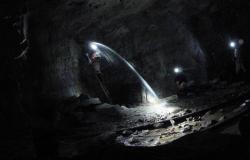“The flood swept away some houses, livestock, and flooded our crops,” laments Timons Fayaba Faba, a resident of the Tougoudé district who came to take refuge in an improvised camp sheltered by a dike, in the south-east of the 9th arrondissement caught between the two rivers.
Like dozens of families, he and his family fled their neighborhood invaded by the waters of the Logone four days ago, now only accessible by canoe.
They found shelter under shelters hastily constructed with branches, rice sacks and cloth. The land south of the dike is completely submerged.
“We lack everything, we no longer have food and we cannot count on the next harvest, destroyed by the flood. Our children no longer go to school and we don’t even have anything to protect ourselves from the next rains and mosquitoes,” laments the 59-year-old man, his eyes hidden behind tinted glasses.
Another cause for concern: according to him, hippos are approaching the dike adjoining the camp. “They are trying to climb onto the embankment. They could destroy it,” he fears. So you have to chase them away by throwing stones at them.
Read also: Chad: general mobilization in the face of floods
The waters of the Chari, which joins its tributary the Logone at N’Djamena, continue to rise and reached a record level of 8.18 meters on Wednesday, according to official measurements.
“Every minute is precious,” warned Prime Minister Allah-Maye Halina during a crisis meeting on Wednesday.
Lack of resources
The last record level of the Chari, at 8.14 meters, dates back to November 13, 2022, when the country was experiencing the heaviest and deadliest rainfall since the early 1960s, according to data from the UN office for humanitarian affairs (Ocha) in Chad.
At the national level, bad weather and floods affect more than 10% of the inhabitants of this immense desert country in Central Africa, according to the report published at the beginning of October by Ocha, counting 576 deaths.
“I get up in the middle of the night to check that the flood is not progressing further. If this is the case, I fill sandbags to reinforce the dike that still protects my room,” explains Silas Diokouné, 65, a resident of Walia, one of the poorest neighborhoods of N’Djamena, in the north. of the 9th arrondissement.
Read also: Chad: alert on the rapid rise of the Chari and Logone rivers
Leaning with all his weight on his cane, walking with difficulty, this man works in front of the pile of sandbags which acts as a barrier inside his courtyard. The waters have already invaded part of the residence, small buildings made of red earth bricks are beginning to collapse.
With around ten centimeters still separating the waters of the river from the top of the dike, his neighbor’s abandoned house now serves as a rampart.
“We feel abandoned, it is only the +Active Youth of the 9th + who came to help us by distributing bags and shovels,” adds the sixty-year-old. Volunteers from this association travel through flooded neighborhoods to help the population. They are monitoring the condition of the dike erected in a few months last year. At the slightest sign of infiltration, they use a whistle to mobilize the neighborhood, fill sandbags and plug the breaches.
“More than 5,000 bags were given to us, and we redistributed them all where the need was most urgent,” explains Ezéchiel Minnamou Djobsou, the deputy coordinator of Active Youth in the 9th district.
The association bought shovels with donations and received two 4x4s and eight motorcycles on loan. “We still need 15,000 additional bags”, canoes to access flooded areas, we would also need “motor pumps, tarpaulins, picks, shovels and wheelbarrows”, underlines the 33-year-old volunteer.
Between destruction and care for victims, the needs in Chad are estimated at 129 million dollars (118 million euros) and are currently covered at around 15%, according to Ocha.
Par Le360 Africa (with AFP)
10/10/2024 at 3:21 p.m.






